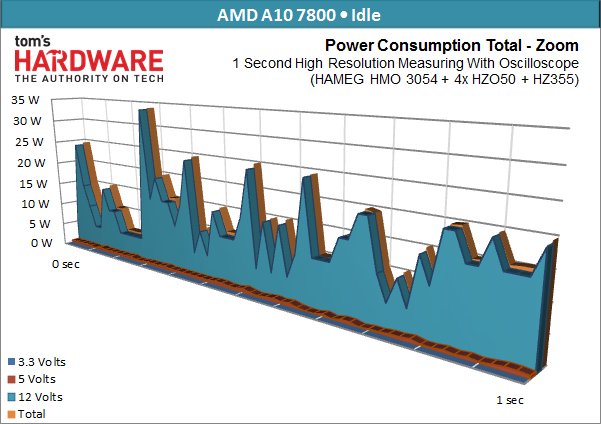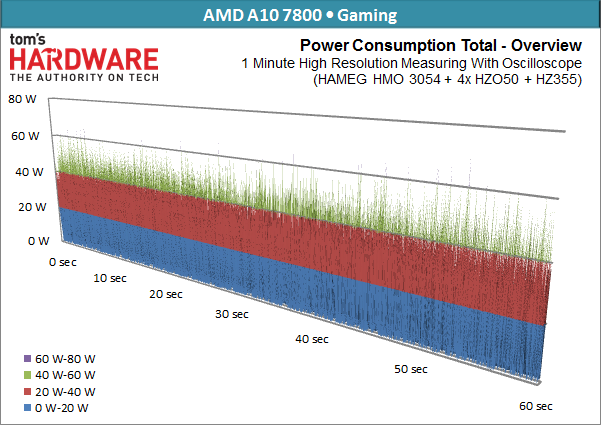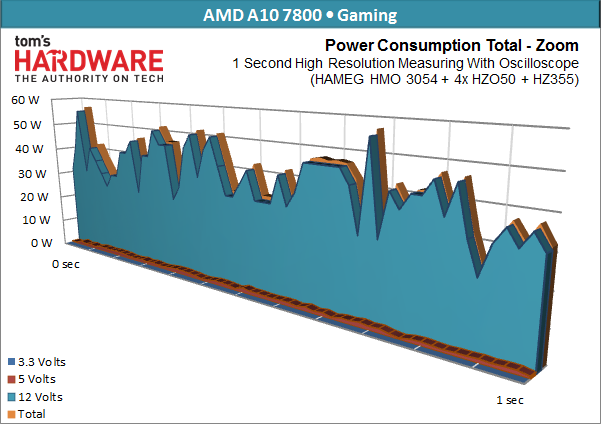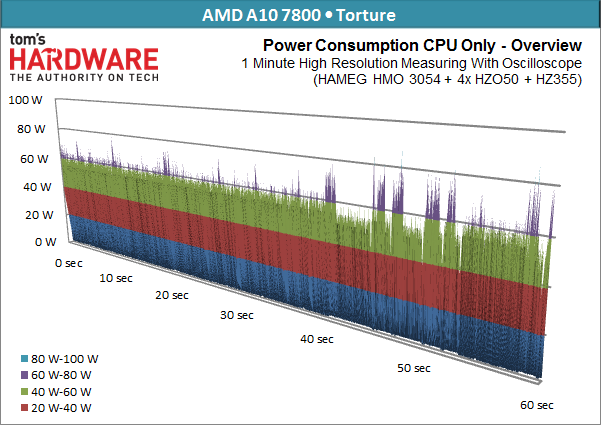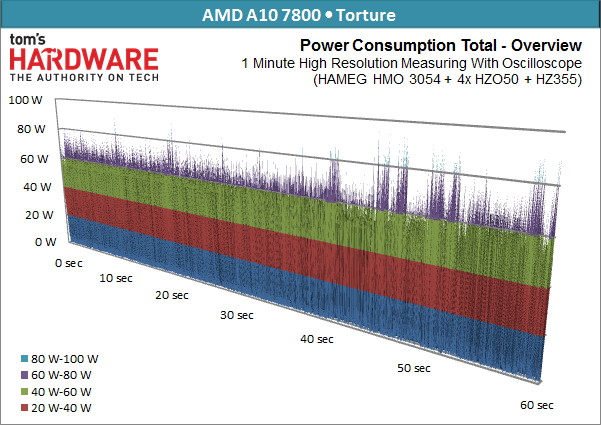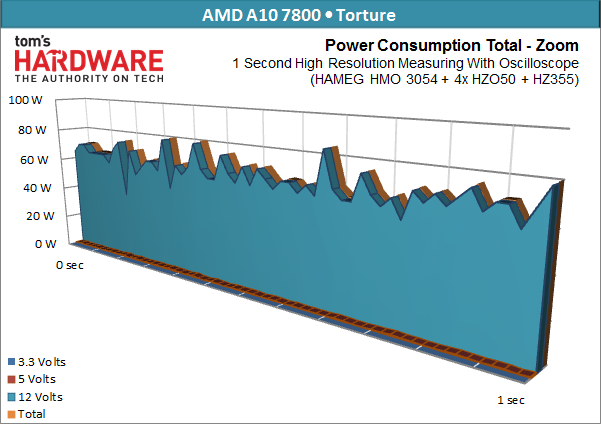AMD A10-7800 APU Review: Kaveri Hits the Efficiency Sweet Spot
AMD recently introduced another model in its A-series APU family called the A10-7800. While we already know a lot about the Kaveri architecture, this particular chip's power profile makes it more interesting than the performance-oriented incarnations.
Power Draw: Overview
We collect tons of data from each test run, which we then analyze in different ways. Today, we're going to present the power measurements at idle, under a gaming load, and under the most stress possible. Then, we'll dig into more specific details. The APU's power consumption is measured at the eight-pin 12 V connector. Simultaneously, we get the motherboard and memory draw at the 24-pin ATX connector. Total consumption is the sum of all power rails leading to the motherboard, without the SSD.
AMD promised us an efficiency surprise and, spoiler alert, it delivers. What does that achievement look like in detail, though?
Power Draw at Idle
MSI's motherboard and AMD's APU form an exciting low-power team. At a mere 6.4 W for the APU and 11.7 W for the total system, the platform's draw is impressively low.
While the 19 W measured at the wall socket is quite low as well, PSUs with an 80 PLUS Gold rating fail to hit our efficiency expectations at such a low power draw, even if they still technically comply with the specification. Plug in a DC-DC converter (which we can no longer call a picoPSU for legal reasons) and an efficient wall wart-style PSU; you can achieve less than 15 W at the outlet.
| Power Draw Idle | Minimum | Maximum | Average |
|---|---|---|---|
| CPU +12 V | 4.8 W | 24.0 W | 6.4 W |
| Motherboard +12 V | 0.0 W | 14.4 W | 4.8 W |
| Motherboard +3.3 V | 0.0 W | 0.1 W | 0.0 W |
| Motherboard +5 V | 0.1 W | 1.1 W | 0.4 W |
| System Total | 4.9 W | 38.9 W | 11.7 W |
Power Draw during Gaming
The next efficiency surprise is already waiting for us in the gaming benchmarks. While the A10-7800-based system is just a bit slower than one built using an A10-7850K, its power draw is quite a bit lower (32 W for the APU on average, and 40.3 W for the whole system). Similar to graphics cards, we observe peaks under load as high as 55 W. But the average proves that AMD operates the A10-7800 closer to its architecture's sweet spot. We used Unigine Heaven 4.0 at moderate quality settings to max out the APU, finding the results to be easily reproducible.
| Power Draw Gaming | Minimum | Maximum | Average |
|---|---|---|---|
| CPU +12 V | 7.2 W | 55.2 W | 32.0 W |
| Motherboard +12 V | 0.0 W | 24.0 W | 7.1 W |
| Motherboard +3.3 V | 0.0 W | 0.1 W | 0.1 W |
| Motherboard +5 V | 0.3 W | 1.9 W | 1.1 W |
| System Total | 12.8 W | 70.8 W | 40.3 W |
Power Draw at Full Load
Even at full load, the test system doesn’t exceed AMD's 65 W TDP unless you increase voltage for an overclock. We briefly played around with these motherboard settings, but found that the system took a huge efficiency hit, while performance barely increased. Hence, we went back to the default values and enjoyed an easy-to-cool machine with decent performance.
| Power Draw (Full Load) | Minimum | Maximum | Average |
|---|---|---|---|
| CPU +12 V | 7.2 W | 88.8 W | 56.2 W |
| Motherboard +12 V | 0.0 W | 19.2 W | 6.5 W |
| Motherboard +3.3 V | 0.0 W | 0.1 W | 0.1 W |
| Motherboard +5 V | 0.1 W | 1.7 W | 0.8 W |
| System Total | 13.0 W | 95.0 W | 63.6 W |
Get Tom's Hardware's best news and in-depth reviews, straight to your inbox.

Igor Wallossek wrote a wide variety of hardware articles for Tom's Hardware, with a strong focus on technical analysis and in-depth reviews. His contributions have spanned a broad spectrum of PC components, including GPUs, CPUs, workstations, and PC builds. His insightful articles provide readers with detailed knowledge to make informed decisions in the ever-evolving tech landscape
-
blackmagnum Just to wonder if Microsoft or Sony were to put this chip in their next gaming consoles and give those gamers a fighting chance.Reply -
tiger15 You are stressing power efficiency.Reply
What about comparing those numbers with other offerings? (Intel?) -
Memnarchon Reply13989815 said:Just to wonder if Microsoft or Sony were to put this chip in their next gaming consoles and give those gamers a fighting chance.
Maybe the new consoles lack CPU power (even if they are 8 core, the 1,6Ghz/1,75Ghz cripples them), their GPU part is far more powerful than existing APUs.
PS4's GPU has cores like 7870 and XBOX1 has cores like 7790, in other words more powerful than the 512 core R7 which exists in today's best APU A10-7850K. -
Cryio Wait. You can now CrossFire A10 7850 with GPUs other than the 240 and 250X?Reply
I have a friend with a 7850K and a 260X and he's dying to know if he can CrossFire.
"I see no point in buying a processor that emphasizes on-die graphics and then adding a Radeon R7 265X. Yes, AMD officially recommends it and yes, we tried it out." Can I take this as a yes ? -
gadgety The A8-7600 seems to be the effiency sweet spot in the Kaveri line up, specially at 45W. Trying to compare with of the A10-7800 with the A8-7600, although as far as I can tell just about ALL your tests seem to be done at different settings (e.g. BioShock Infinity is run at Medium Quality Presets rather than the lowest settings as in the test of the A10-7800) so the comparison isn't straightforward. A8-7600 is within 91-94% of the A10-7850K. One item which is comparable is video encoding in Handbrake, where the A8-7600 is at 92.8% of the 7850k, whereas the A10-7800 is at 95.7% of the 7850k. Price wise you'd pay a 63% premium for the A10-7800 over the A8-7600 to get an extremely minute performance advantage, around 3% or so.Reply -
Drejeck Reply
Not accurate.13989815 said:Just to wonder if Microsoft or Sony were to put this chip in their next gaming consoles and give those gamers a fighting chance.
Maybe the new consoles lack CPU power (even if they are 8 core, the 1,6Ghz/1,75Ghz cripples them), their GPU part is far more powerful than existing APUs.
PS4's GPU has cores like 7870 and XBOX1 has cores like 7790, in other words more powerful than the 512 core R7 which exists in today's best APU A10-7850K.
PS4 GPU is a crippled and downclocked 7850 (disabled cores enhance redundancy and less dead chips)
XB1 GPU is a crippled and downclocked R7 260X (as above) and like the 7790 should have AMD True Audio onboard, but they could have changed that. This actually means that CPU intensive and low resolution games are going to suck because the 8 cores are just Jaguar netbook processors.
The reality is that PS4 is almost cpu limited already and the XB1 is more balanced. Now that we've finished speaking of "sufficient" platforms let's talk about the fact that a CPU from AMD and the word efficient are in the same phrase. -
Memnarchon Reply
I think you need to do a little more research since: Reverse engineered PS4 APU reveals the console’s real CPU and GPU specs. "Die size on the chip is 328 mm sq, and the GPU actually contains 20 compute units — not the 18 that are specified. This is likely a yield-boosting measure, but it also means AMD implemented a full HD 7870 in silicon."13990605 said:Not accurate.
PS4 GPU is a crippled and downclocked 7850 (disabled cores enhance redundancy and less dead chips)
13990605 said:XB1 GPU is a crippled and downclocked R7 260X (as above) and like the 7790 should have AMD True Audio onboard, but they could have changed that. This actually means that CPU intensive and low resolution games are going to suck because the 8 cores are just Jaguar netbook processors.
The reality is that PS4 is almost cpu limited already and the XB1 is more balanced. Now that we've finished speaking of "sufficient" platforms let's talk about the fact that a CPU from AMD and the word efficient are in the same phrase.
The PS4 will be CPU limited? Since they write the code/API according to a hardware that it will remain the same for like 7-8 years, such thing as CPU limited especially for a console that runs the majority of games at 1080p, does not exist...
ps: I agree with the downclocked part since they need to save as much power as they can... -
blubbey Reply
Not accurate.13989815 said:Just to wonder if Microsoft or Sony were to put this chip in their next gaming consoles and give those gamers a fighting chance.
Maybe the new consoles lack CPU power (even if they are 8 core, the 1,6Ghz/1,75Ghz cripples them), their GPU part is far more powerful than existing APUs.
PS4's GPU has cores like 7870 and XBOX1 has cores like 7790, in other words more powerful than the 512 core R7 which exists in today's best APU A10-7850K.
PS4 GPU is a crippled and downclocked 7850 (disabled cores enhance redundancy and less dead chips)
XB1 GPU is a crippled and downclocked R7 260X (as above) and like the 7790 should have AMD True Audio onboard, but they could have changed that. This actually means that CPU intensive and low resolution games are going to suck because the 8 cores are just Jaguar netbook processors.
The reality is that PS4 is almost cpu limited already and the XB1 is more balanced. Now that we've finished speaking of "sufficient" platforms let's talk about the fact that a CPU from AMD and the word efficient are in the same phrase.
PS4 is 1152:72:32 at 800MHz, 7850 is 1024:64:32@ 900MHz or so (860MHz release?) It is not a "crippled 7850", the 7850 is a crippled pitcairn (20 CUs is the full fat 7870, PS4 has 18, 7850 16 CUs). "CPU limited" is very PC orientated thinking, things like offloading compute to the GPU will help. No, I'm not saying their CPUs are "good" but they will find ways of offloading that work onto the GPU. -
silverblue ReplyThe A8-7600 seems to be the effiency sweet spot in the Kaveri line up, specially at 45W. Trying to compare with of the A10-7800 with the A8-7600, although as far as I can tell just about ALL your tests seem to be done at different settings (e.g. BioShock Infinity is run at Medium Quality Presets rather than the lowest settings as in the test of the A10-7800) so the comparison isn't straightforward. A8-7600 is within 91-94% of the A10-7850K. One item which is comparable is video encoding in Handbrake, where the A8-7600 is at 92.8% of the 7850k, whereas the A10-7800 is at 95.7% of the 7850k. Price wise you'd pay a 63% premium for the A10-7800 over the A8-7600 to get an extremely minute performance advantage, around 3% or so.
Yes, but the A8-7600 has a 384-shader GPU. I suppose it depends on whether you want to use the GPU or not.


